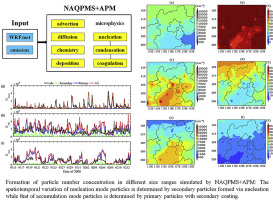Environmental Pollution ( IF 8.9 ) Pub Date : 2017-09-12 , DOI: 10.1016/j.envpol.2017.08.103 Xueshun Chen , Zifa Wang , Jie Li , Huansheng Chen , Min Hu , Wenyi Yang , Zhe Wang , Baozhu Ge , Dawei Wang

|
In this study, a three-dimensional air quality model with detailed aerosol microphysics (NAQPMS + APM) was applied to simulate the fine particle number size distribution and to explain the spatiotemporal variation of fine particle number concentrations in different size ranges over Beijing and surrounding areas in the haze season (Jan 15 to Feb 13 in 2006). Comparison between observations and the simulation indicates that the model is able to reproduce the main features of the particle number size distribution. The high number concentration of total particles, up to 26600 cm−3 in observations and 39800 cm−3 in the simulation, indicates the severity of pollution in Beijing. We find that primary particles with secondary species coating and secondary particles together control the particle number size distribution. Secondary particles dominate particle number concentration in the nucleation mode. Primary and secondary particles together determine the temporal evolution and spatial pattern of particle number concentration in the Aitken mode. Primary particles dominate particle number concentration in the accumulation mode. Over Beijing and surrounding areas, secondary particles contribute at least 80% of particle number concentration in the nucleation mode but only 10–20% in the accumulation mode. Nucleation mode particles and accumulation mode particles are anti-phased with each other. Nucleation or primary emissions alone could not explain the formation of the particle number size distribution in Beijing. Nucleation has larger effects on ultrafine particles while primary particles emissions are efficient in producing large particles in the accumulation mode. Reduction in primary particle emissions does not always lead to a decrease in the number concentration of ultrafine particles. Measures to reduce fine particle pollution in terms of particle number concentration may be different from those addressing particle mass concentration.



























 京公网安备 11010802027423号
京公网安备 11010802027423号